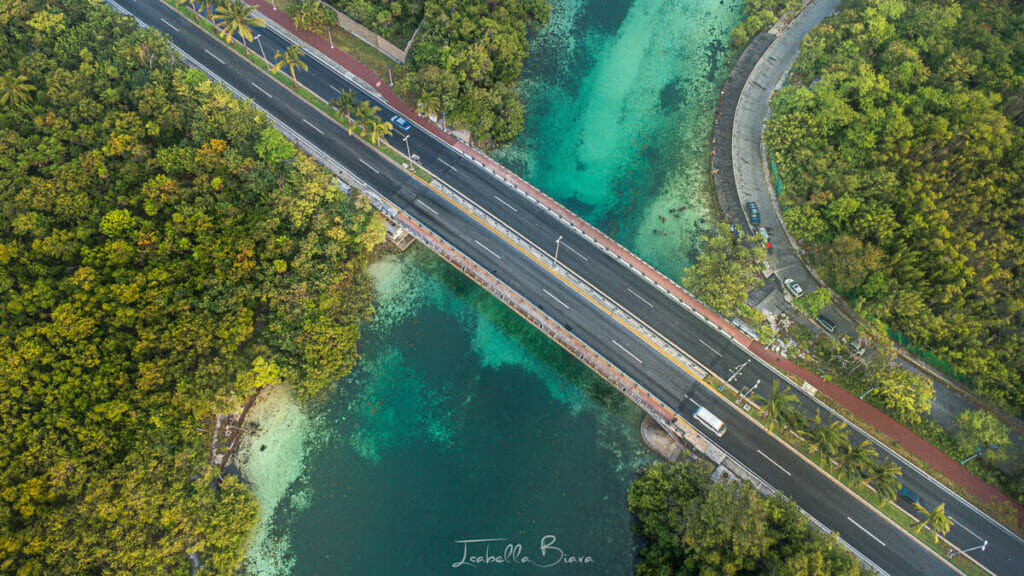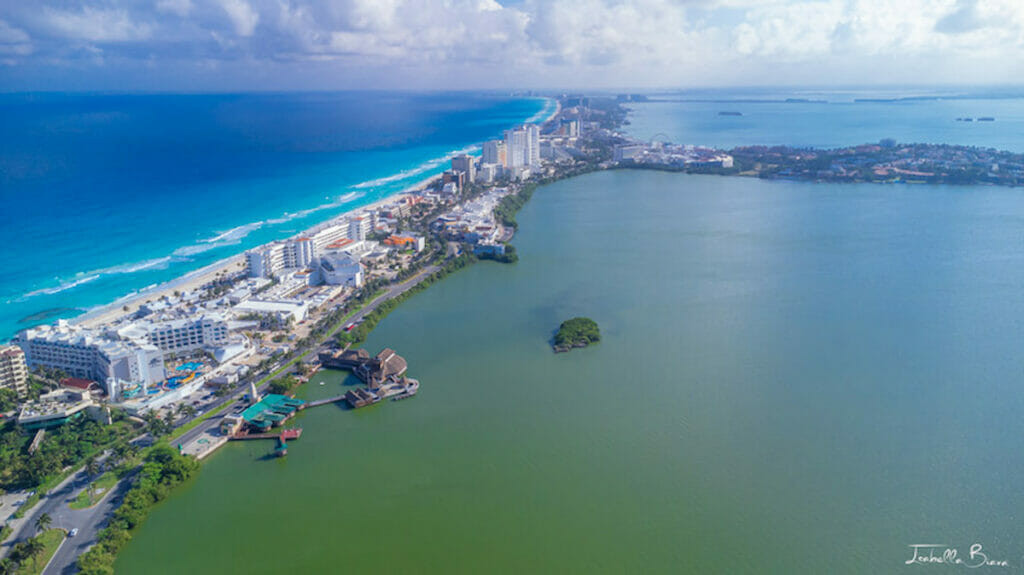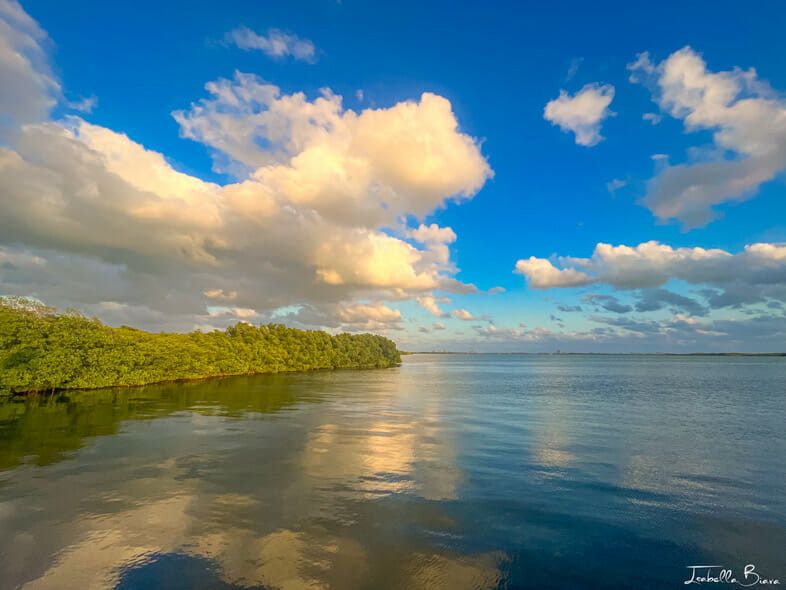Are there crocodiles in Cancun, Mexico? Absolutely! Cancun, Mexico, is known for its stunning beaches and vibrant nightlife, and it’s also home to crocodiles, especially in the Nichupté Lagoon. For LGBTQ+ travelers and anyone else planning a visit, understanding where these reptiles live and how to stay safe is key. With gaymexico.net, you can find reliable information and resources to ensure a safe and enjoyable trip to Cancun. You’ll be able to safely explore LGBTQ-friendly travel spots, Cancun wildlife, and local ecosystems.
1. Cancun Crocodile Habitats and Locations
Cancun is a well-known crocodile habitat, with several locations where you can observe these fascinating animals safely in their natural environment.
Punta Nizuc: Spotting Crocodiles in the Mangroves
Punta Nizuc is an excellent location to spot crocodiles basking in the mangroves. Although locals might swim in the area, it’s wise to exercise caution due to the possible presence of crocodiles.
 Cancun Punta Nizuc Bridge
Cancun Punta Nizuc Bridge
Sanctuary Reserve of Mangroves of Nichupté: A Natural Habitat
The Nichupté Lagoon is a protected natural reserve where crocodiles live alongside diverse wildlife. While paddle boarding might be risky due to the possibility of falling, kayaking tours are a safer option. These tours are often guided by professionals familiar with the animals’ habitats, which ensures a safe and enjoyable experience. The calm waters make kayaking a relaxing way to observe birds and other wildlife, especially in the morning before the motorboats start their engines.
Signs warning about crocodile presence are posted on the lagoon side of the Cancun Hotel Zone. This is due to past incidents of crocodiles wandering along the roadside. Exercise caution or avoid walking on that side of the road to prevent any unpleasant encounters, considering we have been encroaching on their natural habitat.
 Drone view of Cancun beach and lagoon
Drone view of Cancun beach and lagoon
Croco Cun Zoo: Encounter Crocodiles Up-Close
Croco Cun Zoo presents a unique opportunity to encounter crocodiles in a controlled setting. Unlike traditional zoos, Croco Cun focuses on ecological needs, housing animals that have been donated, rescued, or seized by environmental authorities.
The zoo plays a vital role in fauna conservation through education and interaction with visitors. While opinions on zoos vary, Croco Cun offers an environment where you can learn about and observe crocodiles up close.
Safety and Viewing Guidelines
- Distance: Keep a safe distance of at least 5 meters (approximately 16 feet) from crocodiles.
- Feeding: Never attempt to feed crocodiles, as it is both illegal and dangerous.
- Guided Tours: Join a guided tour for educational insights and added safety.
2. Best Times to See Crocodiles in Cancun
Understanding the seasonal and daily patterns of crocodiles in Cancun will help you maximize your chances of spotting them.
Seasonal Behavior Patterns
Crocodiles in Cancun are more visible during the wet season, from June to November. During this time, their natural habitats are replenished and food is plentiful. You’ll likely see them basking or feeding.
- Wet Season: June – November (Increased Visibility)
- Dry Season: December – May (Reduced Visibility)
During the dry season (December to May), crocodiles may be harder to find due to shrinking water sources. Sightings are still possible but may require more patience or a guided tour.
 nichupte lagoon from malecon
nichupte lagoon from malecon
Daily Activity Cycles
Crocodiles are ectothermic, meaning they rely on their environment to regulate body temperature. Their daily activity cycles can guide your viewing plans.
- Morning: Excellent for observing crocodiles as they bask in the sun to warm up.
- Midday: Crocodiles often retreat to shaded areas or water to cool off, making them harder to spot.
- Evening: As temperatures drop, crocodiles become active again, offering another good chance for sightings.
Dawn and dusk provide the best opportunities for crocodile encounters. Always maintain a safe distance and consider a guided tour to enhance your experience.
3. Crocodile Tours and Excursions in Cancun
In Cancun, you can observe crocodiles in their natural habitat through various specialized tours and excursions.
Guided Tours for Crocodile Spotting
Guided tours are a safe and informative way to see crocodiles up close. Professional guides who understand crocodile behavior and habitats lead you through mangroves and areas where crocodiles are known to live.
- Rio Lagartos Biosphere Reserve: This popular destination for crocodile sightings usually includes a boat ride through the mangroves.
- Croco Cun Zoo: A guided walk through this interactive zoo allows for close encounters and education on conservation.
- Nichupté Lagoon: Kayaking tours are available, but crocodile sightings are rare.
Guides ensure your safety and offer valuable insights into these captivating reptiles.
4. Conservation Efforts for Crocodiles in Cancun
Visiting Cancun gives you a firsthand look at efforts to protect local wildlife, including crocodiles. These initiatives are essential for maintaining the balance of local ecosystems and ensuring the survival of these species.
Protecting Crocodile Habitats
- Habitat Protection: Preserving the natural habitats of crocodiles in Cancun is a conservation priority. Encroachment and development pose significant threats, but legislation and local support help preserve habitats. Protected areas and wildlife reserves have been established for this purpose.
- Regulated Tourism: Tourism in Cancun is regulated to minimize human impact on crocodile populations and their habitats. Visits to crocodile habitats are subject to guidelines to protect these animals.
- Environmental Education: Educating the public about crocodiles promotes conservation by teaching locals and visitors the importance of these animals and how to coexist safely. This reduces conflicts and fosters respect and protection.
- Research and Monitoring: Ongoing research and monitoring of crocodile populations provide essential data for informed conservation actions. This includes tracking crocodile numbers, health, and behavior, which helps adapt management strategies as needed. According to research from the National Commission of Protected Natural Areas (CONANP) in July 2023, constant monitoring and research contribute to the creation of effective conservation strategies, guaranteeing the enduring survival of crocodiles in Cancun.
5. Understanding Crocodile Behavior and Safety Tips
Understanding the behavior of crocodiles and following safety tips is crucial for a safe and enjoyable experience in Cancun.
Recognizing Crocodile Behavior
Crocodiles are generally shy and reclusive animals, but it’s essential to recognize their behaviors to avoid potential risks.
- Basking: Crocodiles often bask in the sun to regulate their body temperature, typically seen during the early morning or late afternoon.
- Feeding: They are most active during dawn and dusk when they hunt for prey.
- Nesting: During the nesting season (usually from April to June), female crocodiles can be more aggressive as they protect their nests.
Essential Safety Tips
- Maintain Distance: Always keep a safe distance from crocodiles, ideally more than 5 meters (16 feet).
- Avoid Feeding: Never feed crocodiles, as this can alter their natural behavior and make them dependent on humans.
- Heed Warnings: Pay attention to warning signs and follow the instructions of local authorities and tour guides.
- Supervise Children: Keep a close watch on children near bodies of water where crocodiles may be present.
- Stay Informed: Learn about crocodile habitats and behaviors to be more aware of potential risks.
First Aid Measures
In the rare event of a crocodile encounter, knowing basic first aid measures can be crucial.
- Control Bleeding: Apply direct pressure to the wound with a clean cloth to stop the bleeding.
- Immobilize the Injured Area: Keep the injured area still to prevent further damage.
- Seek Medical Attention: Immediately seek professional medical help, as crocodile bites can cause severe infections.
6. LGBTQ+ Travel in Cancun: Staying Safe and Informed
For LGBTQ+ travelers visiting Cancun, safety extends beyond wildlife encounters to include awareness and respect for local customs and laws.
Understanding Local Laws and Customs
Mexico has generally progressive laws regarding LGBTQ+ rights, but it’s always wise to be aware of local customs and attitudes.
- Legal Protections: Same-sex marriage is legal in Cancun and throughout Mexico.
- Public Displays of Affection: While public displays of affection are generally accepted, discretion may be appreciated in more conservative areas.
- Respect Local Culture: Be mindful of local customs and traditions, and show respect for the local culture.
Resources for LGBTQ+ Travelers
- GayMexico.net: Provides up-to-date information, travel guides, and resources for LGBTQ+ travelers in Mexico.
- LGBTQ+ Travel Guides: Consult travel guides like “Lonely Planet” and “Out Traveler” for tips and recommendations.
- Local LGBTQ+ Organizations: Connect with local LGBTQ+ organizations for insights and support during your visit.
Safety Tips for LGBTQ+ Travelers
- Stay Informed: Keep up-to-date with local news and events that may affect the LGBTQ+ community.
- Use Reputable Services: Choose reputable accommodations, tour operators, and transportation services that are LGBTQ+-friendly.
- Trust Your Instincts: If a situation feels unsafe or uncomfortable, remove yourself from it.
- Connect with Community: Engage with local LGBTQ+ communities for support and to share experiences.
7. Dispelling Myths About Crocodiles in Cancun
There are several myths and misconceptions about crocodiles in Cancun that need to be addressed to provide a more accurate understanding of these creatures.
Common Myths
- Myth 1: Crocodiles are Always Aggressive:
- Reality: Crocodiles are generally shy and only attack if they feel threatened. Most crocodiles avoid human contact.
- Myth 2: All Crocodiles are Man-Eaters:
- Reality: Only a few species of crocodiles are known to be man-eaters, and encounters are rare.
- Myth 3: Crocodiles Cannot be Found Outside of the Lagoon:
- Reality: While the Nichupté Lagoon is a primary habitat, crocodiles can sometimes venture into nearby areas, especially during the wet season.
Facts About Crocodiles
- Ecological Importance: Crocodiles are apex predators that play a vital role in maintaining the balance of their ecosystems by controlling populations of other species.
- Conservation Status: American crocodiles, found in Cancun, are listed as a vulnerable species, highlighting the importance of conservation efforts. According to the International Union for Conservation of Nature (IUCN), constant habitat loss and human activities have made crocodiles vulnerable.
- Adaptability: Crocodiles have existed for millions of years, demonstrating their ability to adapt and survive in various environments.
Responsible Tourism
- Support Conservation: Engage in eco-friendly tourism activities that support local conservation efforts.
- Educate Others: Share accurate information about crocodiles to dispel myths and promote respect for wildlife.
- Respect Boundaries: Always respect the natural habitats of crocodiles and avoid actions that could disturb or threaten them.
8. How to Choose Eco-Friendly Tours in Cancun
Selecting eco-friendly tours in Cancun ensures that your visit contributes positively to the environment and local communities.
Criteria for Eco-Friendly Tours
- Certification: Look for tours certified by recognized organizations like the Rainforest Alliance or Sustainable Travel International.
- Conservation Practices: Ensure the tour operator follows responsible conservation practices, such as waste reduction, habitat preservation, and wildlife protection.
- Community Involvement: Choose tours that support local communities through employment, fair wages, and cultural preservation.
- Education: Opt for tours that provide educational information about the local ecosystem and conservation efforts.
Questions to Ask Tour Operators
- What are your conservation practices?
- How do you minimize your impact on the environment?
- Do you support local communities?
- Are your guides trained in eco-tourism principles?
Examples of Eco-Friendly Tours in Cancun
- Sian Ka’an Biosphere Reserve: Explore this UNESCO World Heritage Site with a tour operator committed to preserving its natural beauty.
- Crococun Zoo: Visit this interactive zoo focused on wildlife conservation and education.
- Mangrove Kayak Tours: Enjoy a guided kayak tour through the mangroves with a focus on minimal environmental impact.
9. Navigating Cancun: Transportation and Accessibility
Efficient transportation and accessibility are essential for a smooth and enjoyable visit to Cancun.
Transportation Options
- Public Transportation: Cancun has an affordable public bus system that serves most areas of the city.
- Taxis: Taxis are readily available, but it’s important to agree on a fare before starting your journey.
- Rental Cars: Renting a car offers flexibility, but be aware of local driving conditions and traffic.
- Private Shuttles: Private shuttle services provide comfortable and reliable transportation to and from the airport and other destinations.
Accessibility Tips
- Wheelchair Accessibility: Many hotels and tourist attractions offer wheelchair accessibility, but it’s always best to check in advance.
- Transportation for People with Disabilities: Some transportation services provide vehicles equipped for people with disabilities.
- Information Centers: Tourist information centers can provide helpful information about accessibility options and services.
Practical Tips
- Plan Ahead: Research transportation options and accessibility information before your trip.
- Book in Advance: Book transportation and accessible accommodations in advance, especially during peak season.
- Ask Questions: Don’t hesitate to ask questions and seek assistance from hotel staff and local authorities.
10. Frequently Asked Questions About Crocodiles in Cancun
Where can I see crocodiles in Cancun?
Crocodiles can be seen in their natural habitat at the Croco Cun Zoo or while touring the mangroves of the Nichupté Lagoon.
Is it safe to observe crocodiles in Cancun?
Yes, observing crocodiles is safe when done with a licensed tour guide or at accredited institutions like the Croco Cun Zoo.
What’s the best time of year to see crocodiles?
The best time to spot crocodiles is during the warm months from May to August when they are more active. Early morning or dusk are ideal times of day. Check weather conditions, as they can affect crocodile activity.
Can I feed the crocodiles in Cancun?
Never feed wild crocodiles. It is dangerous and illegal.
How large are Cancun’s crocodiles?
American Crocodiles can reach lengths of about 3 to 5 meters. The ones you’ll likely encounter vary in size and can often be seen basking in the sun or swimming in the lagoon.
What should I do if I encounter a crocodile in Cancun?
Maintain a safe distance, avoid sudden movements, and never attempt to feed or interact with the crocodile.
Are there any specific areas in Cancun where crocodiles are more commonly seen?
Crocodiles are more commonly seen in the Nichupté Lagoon, especially in mangrove areas.
Are crocodiles in Cancun dangerous to humans?
Crocodiles are generally shy and not aggressive unless provoked. Following safety guidelines is crucial to prevent incidents.
What conservation efforts are in place to protect crocodiles in Cancun?
Conservation efforts include habitat protection, regulated tourism, environmental education, and ongoing research and monitoring.
Are there any specific tours or excursions focused on crocodile observation in Cancun?
Yes, there are guided tours to the Rio Lagartos Biosphere Reserve and the Croco Cun Zoo that focus on crocodile observation and education.
Conclusion: Enjoying Cancun Safely and Responsibly
Knowing about the presence of crocodiles in Cancun helps ensure a safe and enjoyable experience. For LGBTQ+ travelers and all visitors, understanding local wildlife and conservation efforts is essential. Stay informed, respect local customs, and engage in eco-friendly activities to make your visit memorable. For more information and resources, visit gaymexico.net, where you’ll find travel guides, community support, and tips for exploring Mexico safely and responsibly.
Come explore the beauty and diversity of Cancun with confidence!

